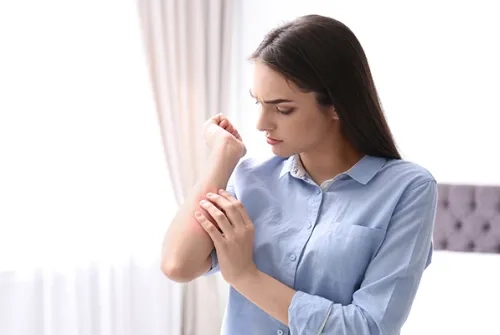Alo Yeditepe
Alo Yeditepe
Scabies Disease
Scabies can exist as long as man exists. The disease can be anywhere where there is a human being, and it cannot survive without a human factor. Therefore, at the beginning of the prevention is to cut off contact with people. Yeditepe University Hospitals Skin Diseases Specialist Asst. Prof. Dr. Özlem Akın explained the scabies disease and the measures to be taken…
Scabies is said to be on the rise lately. Is it accurate? What are the reasons for this?
Yes, there is an increase, however, it is not the increase that we have seen in the last few months. We are talking about an increase we have seen in the last few years since before the pandemic. With the pandemic, its speed seemed to decrease a little, but with the loosening of the pandemic bans, the increased situation started to attract attention.
Overall, why is there an increase in scabies cases?
It is possible to talk about several factors in the increase of scabies. The infectiousness of scabies has increased. The virulence of the mite, which we call Sarcoptes scabiei, has changed over time, it has become stronger, and its contagion has increased.
In addition, developing drug resistance is another factor. There is serious resistance to permethrin cream, which we used to use in the treatment of classic scabies.
Just as antibiotic resistance occurs, over time, animals develop and activate their own mechanisms to survive.
The majority of patients apply by stating whether they have tried them or not.
Of course, it is also important that people do not care about the situation at first. It makes it easier to be infected when people think ''such a thing will not happen to me in this century anymore.” I think one of the reasons for this increase is refugee migration in our country.
Is there any research on this increase?
In fact, there are not many studies I know about the reasons for the increase. This has been detected. I mean, people, dermatologists are aware that this is increasing, but there is no study on why.
Is scabies an important problem?
Scabies is not a very serious problem, but they are very important since they reduce the quality of life. Because the main complaint of the patient is itching. Itching is not a feeling that people can tolerate very much. Most people prefer pain to itching. Therefore, it is a problem that cannot be experienced together.
It starts with a lighter itch at the beginning and then increases in severity in the following weeks and months.
If it is not treated, it will continue for years. Over time, the skin may become thicker and less itchy, but the itching continues. It is not a disease that goes away on its own.
What are the first symptoms in a person with scabies? How does it start?
There is an itching that does not let you sleep at night. Especially an itch that increases at night or increases with heat.
We divide scabies lesions into two. There are also visible lesions next to the itch.
We also divide the skin lesions into two. Primary lesions, that is, tunnels that develop due to the presence of the animal, may occur. Especially in areas such as fingers, palms, wrist circumference, sole, ankle, circumference, genital area, nipple, and umbilical circumference, there may be tunnels where the animal exists.
There may be lesions that develop as a result of four types of allergic reactions to the presence of the animal. As a result of the itching of the patient, the wounds we call excoriation develop. There may be point or linear lesions.
Does scabies pass through contact or through places we come into contact with on public toilets or public transport?
There is a condition we define as prolonged contact in the contamination. In other words, the disease does not pass after shaking hands with the scabies patient. However, contacting these people for a long time or using the items they use may pass by sitting on their seats for a long time. There is no need to get in touch with a sick person. Public transport, planes, taxis, minibusses… All these areas pose a risk of contamination. Cafeterias, restaurants, movie theaters, theaters… If the scabies patient has been sitting in one of these areas for a long time, then the person who uses this area may be infected. In addition, using the same chair, items, clothes, and quilt at home also causes the disease to be transmitted.
Moreover, in addition to wearing the same clothes, the clothes they try for shopping can be contaminated even as a result of the experiment. Therefore, it is necessary to be careful in places where shopping is carried out.
What happens when a person with scabies goes for treatment?
There are medications we use to treat the disease. As I mentioned, patients do not benefit much because they develop resistance to some of the drugs we have used before.
There are tropical medicines that we used to use. We see that it is not very useful in a significant part of them. However, we get positive results from sulfur-containing drugs. If patients use these drugs as needed and are born, the treatment is successful. These drugs are applied all over the head and neck in individuals under 2 years of age. Over the age of two, 100% of the scalp is applied to the entire body except for the ears.
In addition to these drugs applied topically, that is, to the skin surface, oral drug treatment can also be started if rare cases are needed.
How long does the treatment take?
Generally, the patient is treated after three consecutive days of use. However, some patients may need to repeat this. Therefore, we invite the patients to the control one week and ten days after the treatment and if there is still any finding that will suggest active infestation, we continue the treatment again.
So, is this treatment you are talking about only applied to the scabies patient, or should everyone use it?
People who are in close physical contact with the patient, who live in the same house, or who have a sexual partner should receive the same treatment even if they do not have complaints.
What can a person with a diagnosis do about their home or clothes?
- Nails must be cut: When starting treatment, nails should be cut. Since it is an itchy disease, the success of the treatment without cutting the nails may also decrease.
- Rub with a coarse bath glove: Since the parasite lives in the top layer of the skin, a marsupial bath should be taken at home. In this way, a significant part of it can be removed mechanically. However, this bathroom should definitely be done at home, not in common areas such as baths and saunas.
- Treatment should be administered as needed: The patient should use the recommended treatment as recommended. After a bath, the recommended treatment should be applied to the whole body in an age-appropriate manner and repeated every 24 hours for 72 hours. If the hands are washed or bathed during this period, the application should be performed again. So, the body should never be without cream.
- Clothes and used items must be washed: During this period, all items that the patient has come into contact with, such as beds, duvets, linens, costumes, clothes, etc. must be washed above 60 degrees. Items that cannot be washed at 60 degrees should be wrapped in an airtight bag and kept in contact with human skin for seven days. According to the possibilities of the person, if ventilation can be provided so that it does not come into contact with human skin, it can also be so. However, since this is not very possible in large cities such as Istanbul, we recommend that it be wrapped in a way that ensures that it does not breathe and is isolated in a way that will not be contacted for seven days. Shoes must not be neglected.
- The inside of the car should not be forgotten: Again, all areas that the patient comes into contact with, such as the car seat and steering wheel, should be isolated for 7 days.
What can be done to protect it?
- First of all, clothes should be changed as soon as they come from areas such as cinemas, theaters, shopping malls, restaurants, and public transportation.
- If it is a risky situation, clothes must be washed.
- New clothes must not be worn without washing.
- When a guest comes to the house, the clothes they use, linens, towels, etc. must be washed above 60 degrees.
About
Faculty and Year of Graduation:
Marmara University Medical Faculty, 1998
Alo Yeditepe




